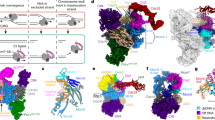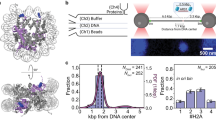Abstract
The components of the replisome that preserve genomic stability by controlling the progression of eukaryotic DNA replication forks are poorly understood. Here, we show that the GINS (go ichi ni san) complex allows the MCM (minichromosome maintenance) helicase to interact with key regulatory proteins in large replisome progression complexes (RPCs) that are assembled during initiation and disassembled at the end of S phase. RPC components include the essential initiation and elongation factor, Cdc45, the checkpoint mediator Mrc1, the Tof1–Csm3 complex that allows replication forks to pause at protein–DNA barriers, the histone chaperone FACT (facilitates chromatin transcription) and Ctf4, which helps to establish sister chromatid cohesion. RPCs also interact with Mcm10 and topoisomerase I. During initiation, GINS is essential for a specific subset of RPC proteins to interact with MCM. GINS is also important for the normal progression of DNA replication forks, and we show that it is required after initiation to maintain the association between MCM and Cdc45 within RPCs.
This is a preview of subscription content, access via your institution
Access options
Subscribe to this journal
Receive 12 print issues and online access
$209.00 per year
only $17.42 per issue
Buy this article
- Purchase on Springer Link
- Instant access to full article PDF
Prices may be subject to local taxes which are calculated during checkout







Similar content being viewed by others
References
Aparicio, O. M., Weinstein, D. M. & Bell, S. P. Components and dynamics of DNA replication complexes in S. cerevisiae: redistribution of MCM complexes and Cdc45p during S phase. Cell 91, 59–69 (1997).
Tercero, J. A., Labib, K. & Diffley, J. F. X. DNA synthesis at individual replication forks requires the essential initiation factor, Cdc45p. EMBO J. 19, 2082–2093 (2000).
Labib, K., Kearsey, S. E. & Diffley, J. F. MCM2–7 proteins are essential components of prereplicative complexes that accumulate cooperatively in the nucleus during G1-phase and are required to establish, but not maintain, the S-phase checkpoint. Mol. Biol. Cell 12, 3658–3667 (2001).
Pacek, M. & Walter, J. C. A requirement for MCM7 and Cdc45 in chromosome unwinding during eukaryotic DNA replication. EMBO J. 23, 3667–3676 (2004).
Shechter, D., Ying, C. Y. & Gautier, J. DNA unwinding is an Mcm complex-dependent and ATP hydrolysis-dependent process. J. Biol. Chem. 279, 45586–45593 (2004).
Jares, P. & Blow, J. J. Xenopus cdc7 function is dependent on licensing but not on XORC, XCdc6, or CDK activity and is required for XCdc45 loading. Genes Dev 14, 1528–1540 (2000).
Masuda, T., Mimura, S. & Takisawa, H. CDK- and Cdc45-dependent priming of the MCM complex on chromatin during S-phase in Xenopus egg extracts: possible activation of MCM helicase by association with Cdc45. Genes Cells 8, 145–161 (2003).
Walter, J. & Newport, J. Initiation of eukaryotic DNA replication: origin unwinding and sequential chromatin association of Cdc45, RPA, and DNA polymerase α. Mol. Cell 5, 617–627 (2000).
Zou, L. & Stillman, B. Assembly of a complex containing Cdc45p, replication protein A, and Mcm2p at replication origins controlled by S-phase cyclin-dependent kinases and Cdc7p–Dbf4p kinase. Mol. Cell Biol. 20, 3086–3096 (2000).
Forsburg, S. L. Eukaryotic MCM proteins: beyond replication initiation. Microbiol. Mol. Biol. Rev. 68, 109–131 (2004).
Kanemaki, M., Sanchez-Diaz, A., Gambus, A. & Labib, K. Functional proteomic identification of DNA replication proteins by induced proteolysis in vivo. Nature 423, 720–725 (2003).
Kubota, Y. et al. A novel ring-like complex of Xenopus proteins essential for the initiation of DNA replication. Genes Dev. 17, 1141–1152 (2003).
Takayama, Y. et al. GINS, a novel multiprotein complex required for chromosomal DNA replication in budding yeast. Genes Dev. 17, 1153–1165 (2003).
Makarova, K. S. et al. Ancestral paralogs and pseudoparalogs and their role in the emergence of the eukaryotic cell. Nucleic Acids Res. 33, 4626–4638 (2005).
Rigaut, G. et al. A generic protein purification method for protein complex characterization and proteome exploration. Nature Biotechnol. 17, 1030–1032 (1999).
Calzada, A. et al. Molecular anatomy and regulation of a stable replisome at a paused eukaryotic DNA replication fork. Genes Dev. 19, 1905–1919 (2005).
Tourriere, H. et al. Mrc1 and Tof1 promote replication fork progression and recovery independently of Rad53. Mol. Cell 19, 699–706 (2005).
Mohanty, B. K., Bairwa, N. K. & Bastia, D. The Tof1p–Csm3p protein complex counteracts the Rrm3p helicase to control replication termination of Saccharomyces cerevisiae. Proc. Natl Acad. Sci. USA 103, 897–902 (2006).
Brewster, N. K., Johnston, G. C. & Singer, R. A. Characterization of the CP complex, an abundant dimer of Cdc68 and Pob3 proteins that regulates yeast transcriptional activation and chromatin repression. J. Biol. Chem. 273, 21972–21999 (1998).
Orphanides, G. et al. FACT, a factor that facilitates transcript elongation through nucleosomes. Cell 92, 105–116 (1998).
Okuhara, K. et al. A DNA unwinding factor involved in DNA replication in cell-free extracts of Xenopus eggs. Curr. Biol. 9, 341–350 (1999).
Orphanides, G. et al. The chromatin-specific transcription elongation factor FACT comprises human SPT16 and SSRP1 proteins. Nature 400, 284–288 (1999).
Schlesinger, M. B. & Formosa, T. POB3 is required for both transcription and replication in the yeast Saccharomyces cerevisiae. Genetics 155, 1593–1606 (2000).
Belotserkovskaya, R. et al. FACT facilitates transcription-dependent nucleosome alteration. Science 301, 1090–1093 (2003).
Alcasabas, A. A. et al. Mrc1 transduces signals of DNA replication stress to activate Rad53. Nature Cell Biol. 3, 958–965 (2001).
Tanaka, K. & Russell, P. Mrc1 channels the DNA replication arrest signal to checkpoint kinase Cds1. Nature Cell Biol. 3, 966–972 (2001).
Kouprina, N. et al. CTF4 (CHL15) mutants exhibit defective DNA metabolism in the yeast Saccharomyces cerevisiae. Mol. Cell Biol. 12, 5736–5747 (1992).
Miles, J. & Formosa, T. Protein affinity chromatography with purified yeast DNA polymerase α detects proteins that bind to DNA polymerase. Proc. Natl Acad. Sci. USA 89, 1276–1280 (1992).
Hanna, J. S., Kroll, E. S., Lundblad, V. & Spencer, F. A. Saccharomyces cerevisiae CTF18 and CTF4 are required for sister chromatid cohesion. Mol. Cell Biol. 21, 3144–3158 (2001).
Zhou, Y. & Wang, T. S. A coordinated temporal interplay of nucleosome reorganization factor, sister chromatin cohesion factor, and DNA polymerase α facilitates DNA replication. Mol. Cell Biol. 24, 9568–9579 (2004).
Fien, K. et al. Primer utilization by DNA polymerase α-primase is influenced by its interaction with Mcm10p. J. Biol. Chem. 279, 16144–16153 (2004).
Ricke, R. M. & Bielinsky, A. K. Mcm10 regulates the stability and chromatin association of DNA polymerase α. Mol. Cell 16, 173–185 (2004).
Kim, R. A. & Wang, J. C. Function of DNA topoisomerases as replication swivels in Saccharomyces cerevisiae. J. Mol. Biol. 208, 257–267 (1989).
Brill, S. J., DiNardo, S., Voelkel-Meiman, K. & Sternglanz, R. Need for DNA topoisomerase activity as a swivel for DNA replication for transcription of ribosomal RNA. Nature 326, 414–416 (1987).
Diffley, J. F. X., Cocker, J. H., Dowell, S. J. & Rowley, A. Two steps in the assembly of complexes at yeast replication origins in vivo. Cell 78, 303–316 (1994).
Chong, J. P. J., Mahbubani, H. M., Khoo, C.-Y. & Blow, J. J. Purification of an MCM-containing complex as a component of the DNA replication licensing system. Nature 375, 418–421 (1995).
Kubota, Y. et al. Identification of the yeast MCM3-related protein as a component of Xenopus DNA replication licensing factor. Cell 81, 601–609 (1995).
Tanaka, T., Knapp, D. & Nasmyth, K. Loading of an Mcm protein onto DNA-replication origins is regulated by Cdc6p and CDKs. Cell 90, 649–660 (1997).
Coleman, T. R., Carpenter, P. B. & Dunphy, W. G. The Xenopus Cdc6 protein is essential for the initiation of a single round of DNA replication in cell-free extracts. Cell 87, 53–63 (1996).
Donovan, S., Harwood, J., Drury, L. S. & Diffley, J. F. X. Cdc6-dependent loading of Mcm proteins onto pre-replicative chromatin in budding yeast. Proc. Natl Acad. Sci. USA 94, 5611–5616 (1997).
Dohmen, R. J., Wu, P. & Varshavsky, A. Heat-inducible degron: a method for constructing temperature-sensitive mutants. Science 263, 1273–1276 (1994).
Labib, K., Tercero, J. A. & Diffley, J. F. X. Uninterrupted MCM2–7 function required for DNA replication fork progression. Science 288, 1643–1647 (2000).
Osborn, A. J. & Elledge, S. J. Mrc1 is a replication fork component whose phosphorylation in response to DNA replication stress activates Rad53. Genes Dev. 17, 1755–1767 (2003).
Katou, Y. et al. S-phase checkpoint proteins Tof1 and Mrc1 form a stable replication-pausing complex. Nature 424, 1078–1083 (2003).
Simmons, D. T., Melendy, T., Usher, D. & Stillman, B. Simian virus 40 large T antigen binds to topoisomerase I. Virology 222, 365–374 (1996).
Wobbe, C. R. et al. Replication of simian virus 40 origin-containing DNA in vitro with purified proteins. Proc. Natl Acad. Sci. USA 84, 1834–1838 (1987).
Yang, L. et al. Roles of DNA topoisomerases in simian virus 40 DNA replication in vitro. Proc. Natl Acad. Sci. USA 84, 950–954 (1987).
Wold, M. S., Weinberg, D. H., Virshup, D. M., Li, J. J. & Kelly, T. J. Identification of cellular proteins required for simian virus 40 DNA replication. J. Biol. Chem. 264, 2801–2809 (1989).
Ueno, M. et al. PSF1 is essential for early embryogenesis in mice. Mol. Cell Biol. 25, 10528–10532 (2005).
Yoshida, K. et al. Requirement of CDC45 for postimplantation mouse development. Mol. Cell Biol. 21, 4598–4603 (2001).
Gotter, A. L. Tipin, a novel timeless-interacting protein, is developmentally co-expressed with timeless and disrupts its self-association. J. Mol Biol. 331, 167–176 (2003).
Lee, B. S., Grewal, S. I. & Klar, A. J. Biochemical interactions between proteins and mat1 cis-acting sequences required for imprinting in fission yeast. Mol. Cell Biol. 24, 9813–9822 (2004).
Noguchi, E. et al. Swi1 and Swi3 are components of a replication fork protection complex in fission yeast. Mol. Cell Biol. 24, 8342–8355 (2004).
Mayer, M. L. et al. Identification of protein complexes required for efficient sister chromatid cohesion. Mol. Biol. Cell 15, 1736–1745 (2004).
Obama, K. et al. Up-regulation of PSF2, a member of the GINS multiprotein complex, in intrahepatic cholangiocarcinoma. Oncol. Rep. 14, 701–706 (2005).
Acknowledgements
We thank K. Chiang for help with yeast strain construction, E. Schiebel for use of his equipment and Y. Kawasaki and A. Sugino for generously providing us with anti-Mcm10 antibody. We are grateful to J. Blow for helpful discussions and to S.D. Bell for sharing unpublished data. This work was funded by Cancer Research UK from whom K.L. receives a Senior Cancer Research Fellowship and by the EMBO Young Investigator Programme. A.S.D. received a Marie Curie training fellowship from the European Union and M.K. is funded by a Japan Society for the Promotion of Science (JSPS) postdoctoral fellowship for research abroad.
Author information
Authors and Affiliations
Corresponding author
Ethics declarations
Competing interests
The authors declare no competing financial interests.
Supplementary information
Supplementary Information
Supplementary Figures S1, S2, S3, S4, S5, S6, Table 1 and 2 and Supplementary Methods (PDF 3652 kb)
Rights and permissions
About this article
Cite this article
Gambus, A., Jones, R., Sanchez-Diaz, A. et al. GINS maintains association of Cdc45 with MCM in replisome progression complexes at eukaryotic DNA replication forks. Nat Cell Biol 8, 358–366 (2006). https://doi.org/10.1038/ncb1382
Received:
Accepted:
Published:
Issue Date:
DOI: https://doi.org/10.1038/ncb1382
This article is cited by
-
A role for heritable transcriptomic variation in maize adaptation to temperate environments
Genome Biology (2023)
-
miR-28-based combination therapy impairs aggressive B cell lymphoma growth by rewiring DNA replication
Cell Death & Disease (2023)
-
RNA Sequencing and Bioinformatics Analysis Reveals the Downregulation of DNA Replication Genes by Morindone in Colorectal Cancer Cells
Applied Biochemistry and Biotechnology (2023)
-
Identification of replication fork-associated proteins in Drosophila embryos and cultured cells using iPOND coupled to quantitative mass spectrometry
Scientific Reports (2022)
-
Unscheduled DNA replication in G1 causes genome instability and damage signatures indicative of replication collisions
Nature Communications (2022)



